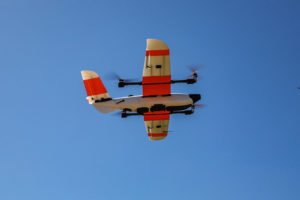Florida-based Censys Technologies manufactures made in the U.S. fixed wing drones – designed to push drone capabilities beyond visual line of sight (BVLOS). DRONELIFE speaks with co-founder Trevor Perrott on BVLOS flight, manufacturing in the U.S., and what surprises him about the commercial drone industry.
Censys was founded in 2017 by a group of aerospace engineers at the Embry-Riddle Aerospace Research Park in Daytona Beach, FL. The company started with a clear goal: building a made in the U.S. fixed wing that “is affordable, delivers incredible data and pushes drone capabilities further,” says co-founder Trevor Perrott.
The team was solving a problem they’d encountered when working in the military UAS sector: the available long-range UAS were too expensive, and the regulatory environment too dynamic, to provide a sustainable commercial solution. The Censys portfolio of VLOS and BVLOS fixed wing drones fills the gap: and this year, customers using Censys drones have had a 100% success rate in receiving BVLOS waivers from the FAA. It’s a stunning achievement – the FAA’s historic approval rate of 1% – and it speaks to the safety case Censys UAVs offer.
BVLOS Flight
Censys offers 2 solutions: VLOS and BVLOS. While BVLOS flight is still not legal without a waiver, Perrott says that the tempo of approvals is accelerating, and the regulatory environment is maturing – but in order to move forward, both industry and regulators need to adjust their mindset.
“Industry needs to adopt a position of understanding the task before the regulator,” Perrott explains. “They’ve been asked to increase the number of aircraft operating in the nation’s airspace from an order of thousands to an order of millions. There are not many industrialists calling for the FAA’s budget – and our taxes – to also increase by three orders of magnitude. So industry needs to recognize the value of the regulator’s role and support them in the safety mission through innovation.”
While Censys drones are manufactured to ensure safety, Perrott points out that to encourage innovation, manufacturers need clear safety standards. “Regulators also need to change their mindset in how they measures success; if safety is truly first, none of us should ever use a car or electricity or travel anywhere near a body of water,” he says. “Safety, by definition, can’t be first, because innovation would be excluded entirely if safety superseded all other factors in our lives. The pursuit of happiness would be trampled in the name of safety.
Our regulators need to declare clear, achievable standards of safety that follow the SMART (specific, measurable, attainable, realistic, and timebound) framework, so that safety and progress coincide and develop symbiotically.”
Manufacturing in the U.S.
Censys makes made in the U.S. fixed wing UAVs – and manufacturing here has been a deliberate choice since their inception. The U.S. drone industry has grown in the last year, as both government and some commercial customers concerned with the security of foreign drone platforms seek out domestic products. Censys had committed to local manufacturing well before the latest publicity and the ban by some U.S. government departments on the purchase of China-made drone technology, however. “Isn’t it traitorous not to?” says Perrott. “Our communities invested in us to make us the people we are. We owe them a return on thier investment,” he says. “Here we stay.”
The Future for Censys – and the Drone Industry
Censys has clear goals for the next year. “We want to make BVLOS more common – 100 new commercial entities operating BVLOS with Censys aircraft in US airspace,” Perrott says. “As we continue to refine our BVLOS strategy and continue to garner success, we hope to see more and more commercial companies fly with Censys Technologies.”
The Sentaero family of long-endurance drones serves a variety of commercial applications – but Censys has seen the most traction in mapping, linear infrastructure inspection, patrol and ISR missions. Still, says Perrott, the expansion of commercial drone applications has suprised him: “The number of industrial verticals and use cases continues to grow at a rate far above and beyond my expectations.”
When the regulatory framework accommodates commercial BVLOS flight, Perrott predicts dramatic changes in the drone industry. “The industry will grow at a rate not yet contemplated in most circles within a BVLOS-enabled regulatory framework,” he says. “Similar to the impact that the internet and cell phone have had to our livelihoods, mass market BVLOS will enable an airborne economy that’s faster, leaner, meaner, and greener than today’s standards.
We can end death by manned helicopter in the energy industry. We can deliver lifesaving medicines to rural areas. We can deliver situational awareness to first responders in emergencies. Valuable problems not yet known will be solved in part by the airborne economy… BVLOS is how to get there.”

Miriam McNabb is the Editor-in-Chief of DRONELIFE and CEO of JobForDrones, a professional drone services marketplace, and a fascinated observer of the emerging drone industry and the regulatory environment for drones. Miriam has penned over 3,000 articles focused on the commercial drone space and is an international speaker and recognized figure in the industry. Miriam has a degree from the University of Chicago and over 20 years of experience in high tech sales and marketing for new technologies.
For drone industry consulting or writing, Email Miriam.
TWITTER:@spaldingbarker
Subscribe to DroneLife here.








[…] Read more about Censys, Made in the US Drones Built for BVLOS Flight. […]